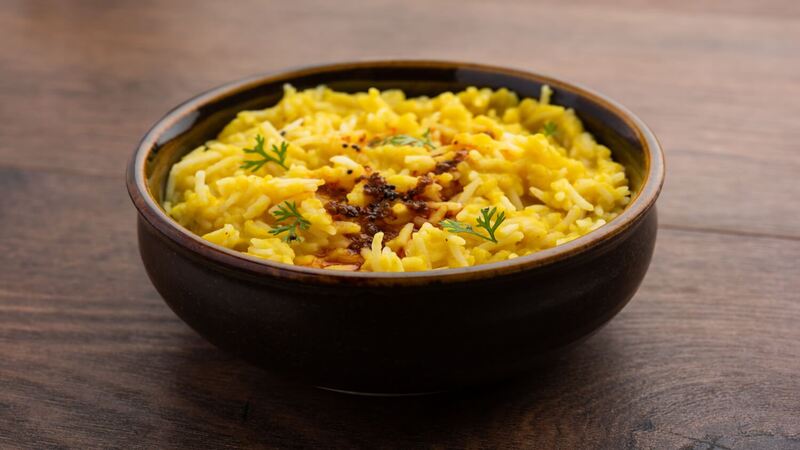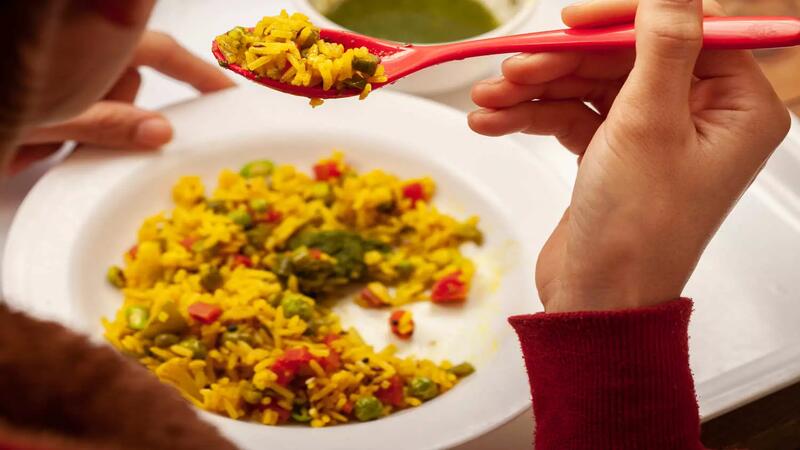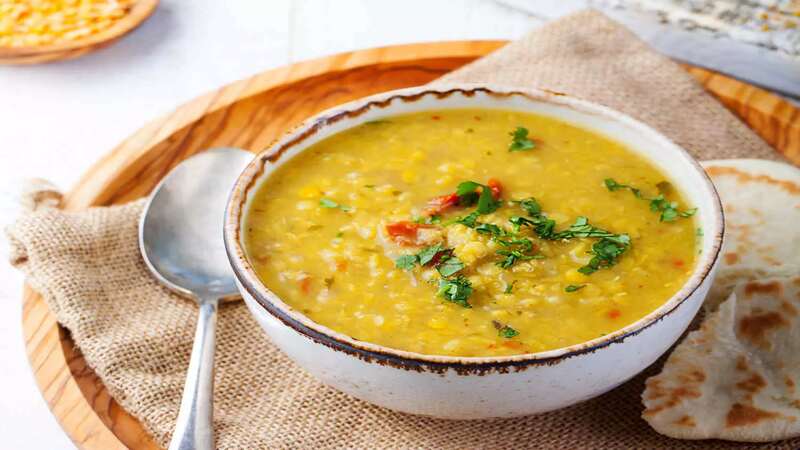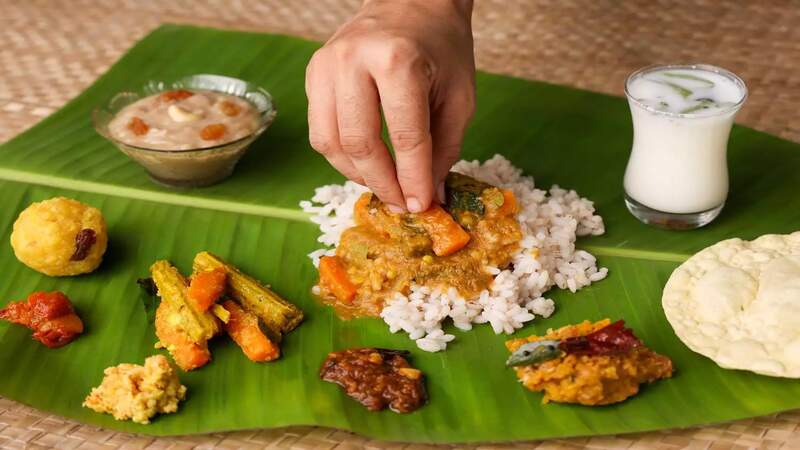
After delivery, many elders suggest that a new mother be given the Khichdi diet after delivery in India. It may appear as a tasteless start to motherhood. However, your body after birth is weak and needs time to recuperate. Along with many other discomforts, it may not be very wise to have foods that stress your digestive system.
Read on to know why Khichdi is recommended after delivery. Also remember that your body also needs iron, calcium, minerals, and vitamins, and hence the diet needs to be complemented with fruits, vegetables, milk, and other sources of protein.
What is Khichdi?
Khichdi is a simple one-pot classic and humble meal traditionally served on all occasions. Its term is derived from Sanskrit as Khiccha meaning a combination of rice and dal (1).
This dish is inspired by an Anglo-Indian dish called Kedgeree. Khichdi is called by different names in different languages- Khisri in Assamese, Kisuri in Sylheti, Khichuri in and Khechidi in Odisha.
Khichdi is meant for all ages, be it rich or poor. The best part is easy preparation, nourishing, wholesome, and light in digestion. It is made in several variations in different variations such as Bajra Khichdi from Rajasthan, Jowar Kichu from Gujarat, and many more.
Why Is The Khichdi Diet Recommended After Delivery?

Since the body is very weak after the delivery, it is believed that the khichdi will be easy on the stomach and thus is highly recommended due to its digestible properties. The gastric organs are not as motile as they should be, owing to the stress of delivery. Hence, you are likely to have an upset bowel and urinary movement.
Moreover, you will have difficulty passing stools, which can stay there for a few days. Diet thus needs to be modified because you could be experiencing pain and discomfort in stitches, especially if you have had a C-section or an episiotomy.
Add to that the emotional anxiety and post-partum mood swings, which can wreck hormones. Hence, your diet should comprise food that does not put a lot of stress on the digestive system, is easy on you, and provides ample nutrition. Not recommended medically though, but there is no harm in opting to eat healthy and light khichdi along with other foods if you like.
How is Khichdi Diet Beneficial For A New Mother?
Traditionally Khichdi is a beloved comfort dish in Indian homes. The ingredients used for making are simply available from the kitchen and take less time to prepare. This dish is a quick and nourishing fix for new mothers. Here are some of the benefits of khichdi diet after delivery.
1. Promotes Digestion
Post-delivery, women experience gastric reflux and flatulence making them incapable of coping with the demands, especially breastfeeding. Khichdi, ideally made with dals and whole grains is easy to digest, assimilate, and absorb in the body. The inclusion of spices such as turmeric (haldi), cumin (jeera), and asafoetida (hing) adds flavor and eases digestion by increasing digestive enzymatic activity and releasing bile.
2. Satisfies Appetite
Most mothers post-delivery struggle with fluctuating appetites and challenges to cope with nutritional needs. Incorporating khichdi provides a sense of fullness and that’s why this humble dish is a big yes to include in major meals. The feeling of satiety via khichdi not only assists in portion control but suppresses overeating greatly.
3. Aids in Detoxification
Post-delivery, mothers have lower metabolic rates which affects the recovery. The moong dal and hing (2) in addition to rice present in Khichdi improve overall metabolism and cleanse the body due to their richness in phenols. It scavenges free radicals which thereby reduces inflammation and any unnecessary activity in the body. As per Ayurveda, Khichdi is a detox food that balances the basic elements in the body.
3. Rich in Essential Nutrients
Khichdi is harmoniously blended with both macro and micronutrients. This delectable dish satisfies the complementary value of protein due to the presence of essential amino acids (3). The goodness of B-complex vitamins and minerals ensures all-round nutrition. The use of fat in Khichdi- ghee (homemade) not only flavors the dish but promotes longevity, and strengthens the nervous system and joints of new mothers.
Nutritive Value of Khichdi

Khichdi is a simple dish with a comforting mixture of rice, dal, and seasonal vegetables. The dish has a distinctive taste, especially with hand-pounded spices and a dollop of ghee. This dish complements all the essential nutrients required by new mothers after childbirth.
| Quality Characterstics | Value |
| Moisture % | 6.3 |
| Ash% | 3.6 |
| Fat g/100 g | 0.6 |
| Protein g/100 g | 12.7 |
| Carbohydrate g/100g | 76.8 |
| Energy kcal/100 g | 363.4 |
| Sodium g/100g | 1.2 |
| Potassium mg/100g | 390 |
| Calcium mg/100 g | 292.6 |
| Iron mg/100g | 4.1 |
Different Types of Khichdi That Can Be Given to a New Mother
There are different khichdi recipes that new mothers can easily include in their daily meals. You can modify the recipes as per ingredients availability and therefore results are flavourful and full of health. Some of them include
a. Basic Khichdi Recipe
This is the easiest recipe made with spices such as bay leaves, cumin seeds, ginger, and asafoetida sauteed in ghee. Small-grain rice and moong dal are the core ingredients with the addition of chopped onions, tomatoes, turmeric, salt, and green chilies. It is prepared in a pressure cooker; it takes less time.
b. Vegetable Khichdi Recipe
The basic version of khichdi is twisted with the goodness of vegetables such as potatoes, french beans, carrot, and green peas. The addition of veggies gives a fibre-filling boost to the dish apart from taste reducing the incidence of constipation among mothers.
c. Daliya Khichdi
This recipe replaces rice with broken wheat (dalia). Dalia is rich in iron and fiber helps to strengthen new mothers by preventing constipation and fatigue as well and helps in lactation.
d. Sabudana Khichdi
This is delicious Maharashtrian-style khichdi made from tapioca (sabudana), a great food post delivery. Tapioca helps in strengthening and healing muscles and bones. The addition of peanuts and ginger (4) in this khichdi not only adds taste but also acts as promising natural galactogues.
e. Millet Khichdi
Millets such as barley, jowar, ragi, and bajra are mother-friendly superfoods. The protein present in Millet helps to strengthen the body besides increasing the supply of mother’s milk. (Hence incorporating them in the form of porridge or khichdi can be a great nutritious choice. Women who are allergic to millet must be careful or avoid having this type of khichdi.
Is Khichdi Alone Enough For a New Mother?
A new mother’s body needs lots of iron and protein, and a lot of calories as well. In our country, elders of the family make traditional sweets like panjiri, halwa, gondha ka laddoo, etc. made from ghee nuts, and sugar and are high in calories. They are also traditionally believed to help new mothers in recovery and the production of breast milk.
However, let your hunger be guided by your body’s needs and activity levels. You must know that during pregnancy you have deposited some fat stores in your body, so you do not need to consume fatty or sugary foods. Some people say that eating calorie-rich foods will boost the production of breast milk, though that is not completely true. Having a balanced diet is the key to a new mother staying healthy and ensuring she produces enough breastmilk for her baby.
What Additional Foods Must A New Mother Take?

Khichdi contains of daal and rice and has proteins and carbohydrates. You must compensate your khichdi diet with other healthy foods across all food groups. Khichdi is soft to chew, easy to prepare fresh and cooks quickly. It is soft and easy to eat, If you are doing so, then going on a khichdi diet is not a problem.
Fresh fruits and juices are also recommended, though packaged juices should be avoided owing to their high sugar content. Further, a regular intake of fluids, especially water may help reduce constipation. Many diseases are water-borne, so always ensure you have filtered, boiled, or packaged drinking water only. A well-balanced complementary diet consisting of varied food groups will ensure that you get enough nutrients to be on khichdi as the mealtime dish.
Post-delivery, the journey of new mothers becomes a bit tough as she has to take care of herself and the infant. Moreover, she needs to be careful in choosing healthy and wise options from food groups to ensure proper breast milk production and recovery. Not just food, she should give due attention to consuming fluids to prevent dehydration. Traditional foods such as sabudana kheer, panjiri, gond ka laddoo, methi laddoo which provide sufficient energy, satiate hunger and provide essential nutrients to strengthen new mothers are excellent options. Have a balanced diet with foods like khichdi and the above foods for a well-rounded nutritious meal. (5)
FAQ’s
1. Should I Go On A Khichdi Diet After Delivery?
Khichdi is an Indian superfood that is easy to prepare and satisfies the tummy with essential nutrients. But khichdi alone won’t help. You will need to include other food sources in the diet to ensure complete nutrition. Your diet should contain foods of all food groups such as fruits and vegetables, whole grains, and dairy.
2. Which Dal is Best After Delivery?
Yellow Moong Dal is an ideal choice after delivery because it is rich in essential nutrients such as protein, carbohydrates, and iron. Moong dal helps to improve agility and immunity. Interestingly, it also acts as galactogogue or milk secretion agent.
3. What Can I Eat For Faster Recovery After Delivery?
Look for food sources balanced in all nutrients especially rich in protein, iron, and fiber such as whole grains, eggs, fruits, and vegetables. Aside from these, certain spices like cumin (jeera), and turmeric (haldi) help accelerate recovery.
References
- Development of ready to cook vegetable khichadi mix by microwave drying technology – [https://www.researchgate.net/publication/351065438_Development_of_ready_to_cook_vegetable_khichadi_mix_by_microwave_drying_technology]
- Hing (Ferula asafoetida). A Review Based Upon its Ayurvedic and Pharmacological Properties – [https://www.researchgate.net/publication/353601868_Hing_Ferula_asafoetida_A_Review_Based_Upon_its_Ayurvedic_and_Pharmacological_Properties]
- Barnyard Millet as a Substitute of Rice in Preparation of khichdi for Diabetics | Semantic Scholar – [https://www.semanticscholar.org/paper/Barnyard-Millet-as-a-Substitute-of-Rice-in-of-for-Joshi-Srivastava/3e4ee6da05a82b446dc589f7aeadfbd5d101b73a]
- The Effect of Ginger on Breast Milk Volume in the Early Postpartum Period: A Randomized, Double-Blind Controlled Trial – [https://www.researchgate.net/publication/306020631_The_Effect_of_Ginger_on_Breast_Milk_Volume_in_the_Early_Postpartum_Period_A_Randomized_Double-Blind_Controlled_Trial]
- STUDY OF FOOD PAT TERN (PREVIOUS AND CURRENT PRACTICES) DURING PREGNANCY AND LACTATION IN KUMAON REGION OF UTTARAKHAND – [https://www.researchgate.net/publication/325871389_STUDY_OF_FOOD_PAT_TERN_PRE_VI_OUS_AND_CUR_RENT_PRAC_TICES_DUR_ING_PREGNANCY_AND_LAC_TA_TION_IN_KUMAON_RE_GION_OF_UTTARAKHAND]

